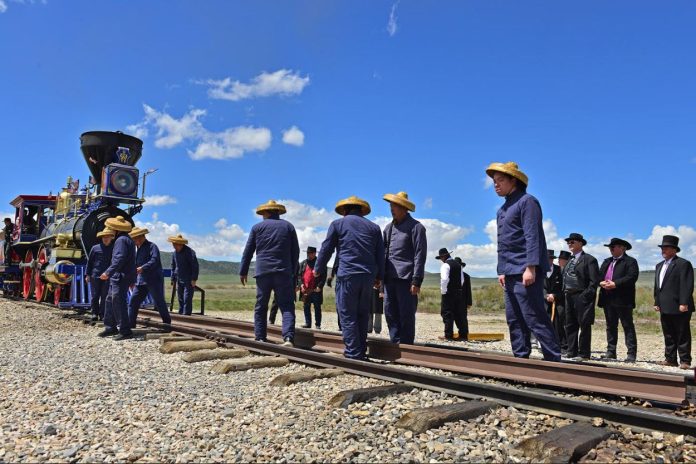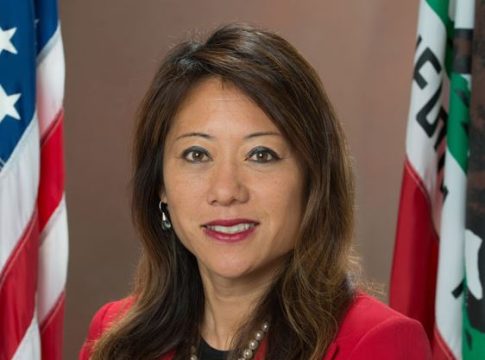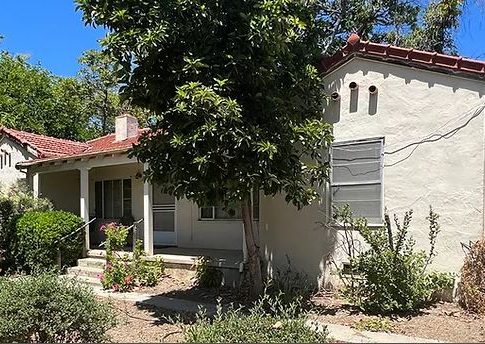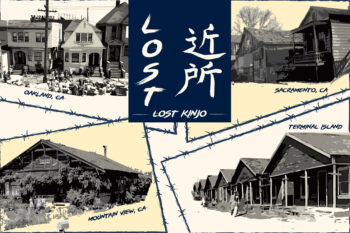By John K Tan
(Editor’s Note: May 10 marked the 155th anniversary of the building of the Transcontinental Railroad. John Tan attended the commemoration and writes about it here, but not before recognizing the role the late photojournalist Corky Lee played in honoring the contributions of the Chinese who built the railroad)
“Dot, dot, dot, D-O-N-E” This was the telegraph message relayed to President Grant and
around the nation at 12:47 P.M. on May 10th, 1869 from Promontory Point, Utah. The
celebration that ensued marked the revolution of travel across the United States. But the
celebration was far from DONE as the famous “champagne photo” of the ceremony of placing
the Golden Spike largely excluded the Chinese railroad workers that played a key part at the
“Wedding of the Rails.”
In 2002, a group photo of Asian Americans by Corky Lee was organized at Promontory
Point during the OCA Convention in Utah and the push to recognize the efforts of the Chinese
laborers began to take steam. By 2014, 12 years later, Lee had spread the word of recreating the
group photo at a larger scale starting with the 145th Anniversary of the Transcontinental
Railroad. A day before the May 10th anniversary, the Department of Labor would induct the
Chinese Laborers to the Hall of Honors in Washington D.C. The timing couldn’t have been
more perfect.
145th anniversary
The excitement permeated the air as Asian Americans and supporters of Chinese railroad
workers gathered as part of the effort by a consortium of 16 organizations in Salt Lake City,
Utah. At a press conference at the Utah State Capitol on May 9th, 2014, Lee would take to the
podium and commit to “an act of Photographic Justice” to reclaim a part of history that neglected
the Chinese railroad workers on behalf of Chinese and Asian Pacific Americans. “I’ll see you
tomorrow…” Lee stated—the two people not to be seen would be the mayor of Salt Lake City
and the governor of Utah claiming conflict of schedule for the press conference.
LATEST STORIES
Three bus load of people stepped on to the grounds of the Golden Spike National Historical
Park at Promontory Point. Consisting of Pan-Asian Americans, oversea Chinese and supporters
of the Chinese railroad workers converged onto the small visitor center at the state park.
The Ladder
Corky Lee Interview by Jennifer Takaki (May 10, 2014)
Corky Lee: I saw that ladder before anybody else did. …I think I made sure somebody was holding on to that ladder because yesterday it rained pretty heavily so the ground was relatively soft. I was conscientious of balance and uh… I think I took a couple of quick photographs… “
Jennifer Takaki: “okay, what were you thinking?”
Corky Lee: I wasn’t thinking anything, I just wanted to make sure I didn’t fall off. Because I had figured out the exposure and that basically was it.
Jennifer Takaki: “What did you yell, what were you saying on top of the ladder?”
Corky Lee: Just before I got on, I heard over the PA system, “Please welcome the Chinese visitors.” And I yelled out “We’re not Chinese visitors, we’re Chinese Americans, we’re Asian Americans!” I would have gone on, but I didn’t think anybody would really hear me …’cause uh, I had no PA system. I know a few people did (hear me.) But that was not basically it.

Jennifer Takaki was there capturing footage for the documentary she had started 10 years ago on Lee (Photographic Justice: Corky Lee Story debut on PBS May 13th, 2024.) Several news outlets were also there, including a reporter for Utah Public Radio. I was also there (an Asian American Journalists Association-NY member and part of the Photojournalist Group) participating in the group picture to honor my great grandfather.
Climbing down from the Union Pacific No. 119 locomotive, I began documenting in the
background. Approaching Lee, Karen Kwan who would three years later would be elected to the Utah State Senate and a reporter from Utah Public Radio. Corky turned to me asking to use my laptop to process the pictures and send it to NPR’s Washington D.C. correspondent that was writing the article on the Chinese Laborers induction to the Hall of Honors.
We left the senator to rejoin the crowd and went to find a place to set the laptop. The three of us were the first to see the group photos and Corky would quickly choose the picture to send to D.C.—but there was a problem, the visitor center didn’t have Wi Fi. We pooled our effort and decided to link-up the laptop through our cell phones, but neither of us three had a signal out in the desert. We grabbed the laptop and each of us, phone in hand with outstretched arms, meandered around the crowd as if we were water dowsing, searched for a cell tower signal. We finally found success and the picture would be
received in Washington D.C. just as the telegram message was received 145 years ago.
The snub

We were celebrating, but still far from being recognized (even with the induction at the
Hall of Honors.) In 2005, as part of the Utah Organization of Chinese Americans, Karen Kwan
and her brother Judge Michael Kwan found success in their petition with the U.S. Board of
Geographic Names to change the China Man’s Arch to a more respectful Chinese Arch (a
limestone formation near the site of the Golden Spike where the Chinese laborers had
encamped.)
In 2002 at the 133rd anniversary, Phil Choy (an architect and professor of Asian
American Studies) barely got the chance to speak at the event and was only allowed to do so
after Corky, attending students, and the audience chanted “let him speak!” Lee would tell Choy,
“I know what happened to you.” referring to the incident at the 100th anniversary when Choy
was the President of the Chinese Historical Society of America in 1969 and was passed over for
his speech to dedicate a plaque honoring the Chinese workers because of an unexpected
appearance of the actor John Wayne.
An emotional Lee choked back tears as he recounted the story and dedicated the group photo efforts to Choy in an interview with journalist Emil Guillermo on May 2017 after Choy’s death.
During the interview with Jennifer Takaki on May 10th, 2014, Lee spoke of three Chinese
railroad workers that celebrated on a parade float in Ogden, UT in 1919- Wong Fook, Lee Chao, and Ging Cui who would have been around 70 years old at the time of the parade.
The names of most Chinese railroad workers during the completion of the
transcontinental railroad would be unknown and unrecognized. After the snub by the Mayor of
Salt Lake City and the Governor of Utah in 2014, Lee stated, “Enough is enough!” in his
interview with Chris Fujimoto about his press conference speech to commit “Photographic
Justice.” By 2017, Kwan would become the first Chinese American to serve on the Utah
legislature and her brother Judge Michael Kwan would form The Chinese Railroad Workers
Descendants Association and be the organization’s first president with co-founder and organizer
Margaret Yee.
The 150th anniversary
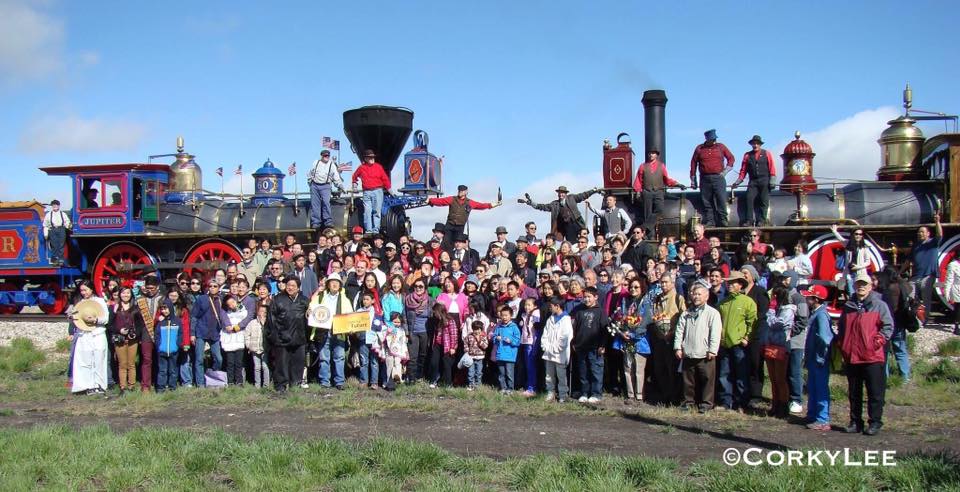
The 150th Anniversary in 2019 welcomed 20,000 attendees from 39 states and overseas.
Lee would capture a photo of the largest gathering of “Chinese” at Promontory Point, UT.
The historical focus now shifted from the railroad tycoons to the laborers who laid the rails.
Chinese and Irish railroad workers were represented in the reenactment for the sesquicentennial
event.
The Chinese Railroad Workers Descendants Association held their celebration of the 155th
Anniversary of Transcontinental Railroads with three days of events from May 9th – May 11th,
2024 that included the reenactment group photo held on May 10th and May 11th.
A symposium at the Utah State Capitol on May 9th began with Robyn Kremer, President of the Spike 150 Foundation, reflecting on the musical performance from the 2019 celebration to recognize the
railroad workers titled As One.
“We started to get a more complete picture of the Chinese railroad workers…as complete as it can be with the history that they were left out of. The workforce was very diverse on all fronts. Union Pacific was Irish, Germans, (Italians, Greeks,) Mormon graders, Civil War vets, and free slaves…”
On May 10th, 2024 members of CRWDA and their supporters would disembark from a bus
that left from the parking lot of the Chinatown Supermarket in South Salt Lake where Karen
Zhou honored Lee with her photography exhibit in 2023. Zhou was invited to be official
photographer this year for CRWDA; and in tow was O.C. Lee from Los Angeles and myself
from New York who were welcomed to photograph the reenactment group photo—just as it was
in 1869 when three photographers were present. Eight Chinese laborers are now part of the
reenactment as a tribute to historical accuracy and when the telegram D-O-N-E is sent, Chinese
and Asian Pacific Americans raised their hands to join in on the “Hip, Hip Hooray!”

Past, Present and Future
Before the reenactment, Rios Pacheco, a tribal elder with the Northwestern Band of the
Shoshone, performs a cleanse with “good medicine” from the land of his mother’s people
offering blessings to the descendants of the Chinese laborers.
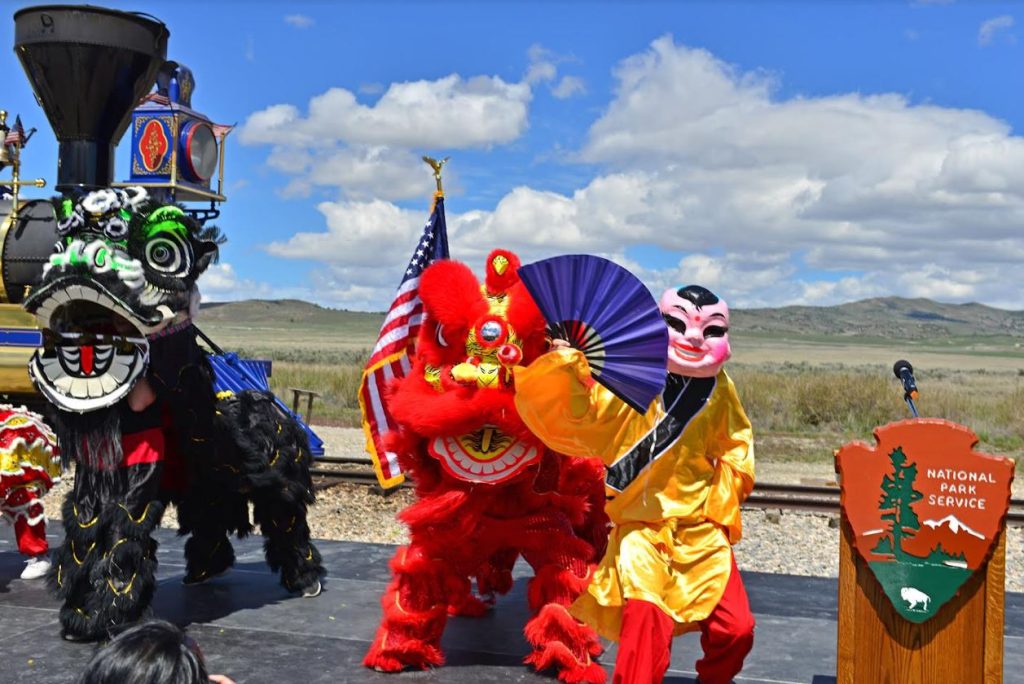
Afterward the 20-star American flag was raised and Margaret Yee, chairwoman of CRWDA introduced the young lion dance performers from Bennion JHS of Taylorsville, the district where Judge Michael Kwan (1962-2020) served before his untimely passing. The event kicked off with remarks from Brandon
Flint, Superintendent of the National Park Service; State Senator Kwan who is also the President of CRWDA;’Scott Weeks, Utah Chairman of the Brotherhood of Locomotive Engineers and Trainmen; and Patrick Bennet, a member of the Hibernian Society of Utah. There was a moment of silence and reflection for the railroad workers during the wreath-laying ceremony. Finally, the loud whistle of the locomotives sounded as they roared down the tracks to take their places.
The final day of events concluded with the CRWDA unveiling of the Resilience and
Perseverance Monument at Utah State Capitol ground. After unveiling the monument dedicated
to Chinese railroad workers of Transcontinental Railroad who worked under some of the harshest
conditions, a reception was held at the State Capitol to honor the oral histories of these brave
laborers.
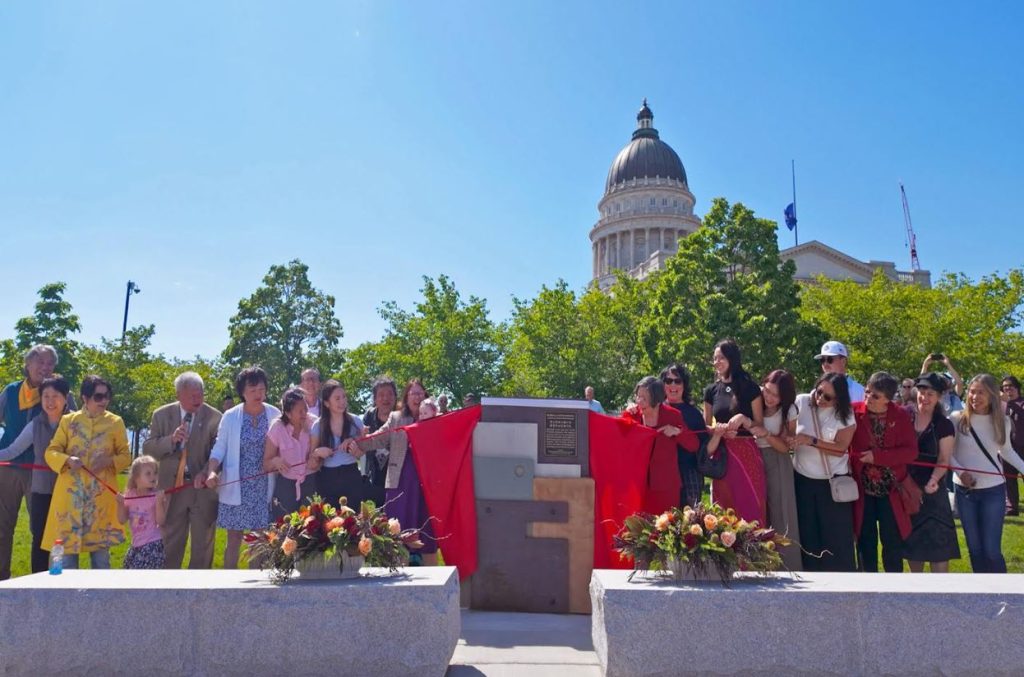
As I stood in front of the monument at the Capitol’s state ground, I recalled the eve of
the 150th celebration in 2019 when I learned of the name and the date of birth of my great
grandfather (曾士傅, Tsang Shi Fu or Dong Shi Foo in Taishanese) after having my father’s
jook bo (genealogy book) researched. Dong Shi Foo was only 5 years of age when the
transcontinental railroad was completed, but the oral history of our family placed my great
grandfather in Seattle before the start of the 20th century where he worked on the railroads.
He had traveled to America twice and returned to China both times. On his third planned trip to
America, he would stop off in Hong Kong and was told by a fortune teller that it would not be of
his best interest to go to America again. He returned to my father’s home village of Dousan in
Taishan. Although this finding ended my research of my great grandfather’s participation with
Central Pacific Railroad…for now—it begins a new chapter in search of Dong Shi Foo in
America and the continued expansion of the railroads across the Pacific Northwest.
AsAmNews is published by the non-profit, Asian American Media Inc. Make a tax-deductible donation of at least $40 or pledge a monthly recurring donation of at least $10 by August 31 and receive a free copy of The Legend of Mu Lan: Heroine of Ancient China, the inspiration for the classic Disney movie. We are supported in part by funding provided by the State of California, administered by the California State Library in partnership with the California Department of Social Services and the California Commission on Asian and Pacific Islander American Affairs as part of the Stop the Hate program. To report a hate incident or hate crime and get support, go to CA vs Hate.

